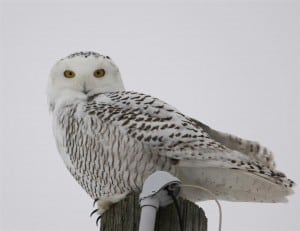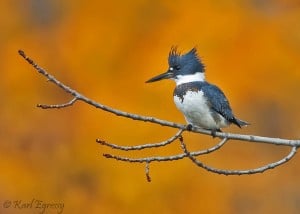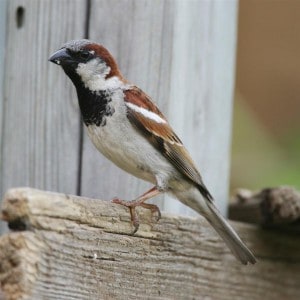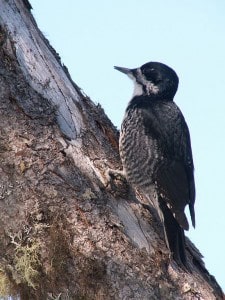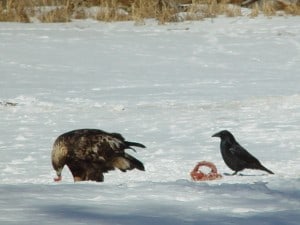Between mid-December and early January, birders from across North, Central and South America take a break from the holiday season excess to spend a day in the fresh air, identifying and counting birds. Dating all the way back to 1900, Christmas bird counts represent the biggest organized birding event in the world and a holiday tradition for over 50,000 birders each year. They first began from a desire to count birds rather than shoot them. In doing so, they effectively gave birth to North America’s modern conservation movement.
We have two local counts. One is centred in Peterborough and the other in Petroglyphs Provincial Park on the north shore of Stony Lake. Both counts cover a circle 24 kilometres in diameter and take one day each to complete. Working in small groups and covering the circle by car, foot and sometimes even snowshoe or ski, birders work from dawn to dusk identifying and counting all of the birds they can find within the circle on the selected day. The Peterborough count usually produces about 50 species, while the Petroglyph count averages 34 species. Numbers are lower on the Petroglyph count because there are fewer types of habitat – most of the territory is forested – fewer feeders and most years there is almost no open water. The Petroglyph count circle (including the six areas surveyed) can be viewed by going to: http://goo.gl/maps/LmG0B
The 62nd Peterborough Christmas Bird Count was held December 15th in temperatures of -15 to -10 C. All areas of still water were frozen. The 35 participants found 51 bird species which is slightly below the ten year count average of 54. The 10189 individual birds recorded was about average for the count. One new species for the count was discovered, namely a Red-necked Grebe found on the Otonabee River between Beavermead Park and the Little Lake Cemetery. Some other notable birds included a Short-eared Owl, a Snowy Owl, 5 Bufflehead ducks (last seen 2004) and three Long-tailed Ducks. The only other time this Arctic-nesting duck turned up on the count was in 1996.
As for numbers of birds, record highs were tallied for Bald Eagles (4), Cooper’s Hawks (10), Red-bellied Woodpeckers (8), Common Raven (10) and Dark-eyed Juncos (453). Snowy Owl (1), Short-eared Owl (1), Belted Kingfisher (3) and Pileated Wood pecker (14) equaled previous records. As is the case every year, there were also notable misses. Observers failed to find any American Black Ducks, Sharp-shinned Hawks or Great Black-backed Gulls.
The most remarkable low number belongs to the once-abundant House Sparrow. Only 39 were recorded, which is the lowest number since the count began. House Sparrows appear to be declining in Ontario, possibly as a result of changes in farming and building practices as well as increased numbers of bird-eating hawks in urban areas. Finch species that were common on last year’s count such as Pine Siskins and Common Redpolls were completely absent this year, having elected to remain in northern Canada where seed crops are abundant. When these birds move southward in late fall and winter and turn up at our feeders, it is usually because of a lack of wild food in their northern breeding range.
The 28th Petroglyph count took place on January 2nd. The 30 participants braved frigid -27 C temperatures in the early morning as well as strong winds that lasted all day. There is little doubt that these difficult conditions contributed to the relatively low number of individual birds recorded (2165). Even Black-capped Chickadees were largely unresponsive to the pishing, squeaking and owl call imitations that usually bring them in close to observers.
Despite the weather, species of note were still recorded. Among these were two spectacular Golden Eagles that were seen feeding on Beaver carcasses that a local trapper had put out. Also of special interest were three American Robins – only the fifth time robins have been found on the count – and a Black-backed Woodpecker. Observers stumbled upon this handsome but uncommon woodpecker at Petroglyphs Provincial Park. As for high numbers, a record 126 Wild Turkeys turned up, virtually all of which were at feeders. The 564 Blue Jays recorded was close to the record high of 653. Large numbers of jays took a pass on migrating south this past fall, electing simply to stay put and to take advantage of central Ontario’s abundant crop of acorns and beech nuts to get them through the winter. Above average numbers of Dark-eyed Juncos and American Tree Sparrows were also noted.
For the fourth year in a row, no Gray Jays were found. Although single birds have been recorded in both Petroglyphs Provincial Park and the Kawartha Nordic Ski Trails earlier this fall and winter, no family groups have been noted for several years. Prior to 2010, the average count for Gray Jays was 5, and they were recorded every year with the exception of 1990. Gray Jays are one of many species that are expected to decrease in number as the climate warms, especially at the southern edge of their range such as here in the Kawarthas.
Low numbers was the order of the day for Ruffed Grouse. Only nine grouse were recorded which is below the 10-year average of 19 and well below the record high of 77. As in the Peterborough count, finch diversity was also poor with only three species tallied, namely Red Crossbill, American Goldfinch and Evening Grosbeak.
Peterborough Count data
The first number is the number of birds counted this year, while the number in parenthesis is the average number recorded over the past 10 years. NR stands for “new record,” ER for “equals record, NFC for “new for count”, LE for “lowest ever” and CP for birds seen during the “count period” but not on the day of the count. Red-necked Grebe 1 (0.1) NFC, Canada Goose 314 (649), Mallard 826 (850), Lesser Scaup 1 (0.1) CP, Common Goldeneye 211 (62), Bufflehead 5 (0.7), Hooded Merganser 3 (3), Common Merganser 7 (42), Long-tailed Duck 3 (0.3) NR, Bald Eagle 4 (0.9) NR, Sharp-shinned Hawk 1 (3) CP, Cooper’s Hawk 10 (5) NR, Red-tailed Hawk 32 (34), American Kestrel 1 (2), Merlin 2 (2), Ruffed Grouse 3 (7), Wild Turkey 147 (119), Ring-billed Gull 13 (114), Herring Gull 9 (245), Glaucous Gull 1 (1) CP, Rock Pigeon 1141 (955), Mourning Dove 858 (644), Eastern Screech Owl 2 (1), Great Horned Owl 6 (4), Snowy Owl 1 (0.1) ER, Short-eared Owl 1 (0.2) ER, Belted Kingfisher 3 (1) ER, Red-bellied Woodpecker 8 (2) NR, Downy Woodpecker 68 (52), Hairy Woodpecker 61 (38), Northern Flicker 3 (2), Pileated Woodpecker 14 (6) ER, Northern Shrike 7 (7 ), Blue Jay 281 (282), American Crow 568 (424), Common Raven 10 (2) NR, Black-capped Chickadee 1500 (1560), Red-breasted Nuthatch 4 (23), White-breasted Nuthatch 55 (65), Brown Creeper 5 (6), Golden-crowned Kinglet 8 (7), American Robin 222 (202), Cedar Waxwing 258 (173), European Starling 729 (1334), Northern Cardinal 83 (83), American Tree Sparrow 413 (326), Song Sparrow 2 (0.9 ), White-throated Sparrow 3 (3), Dark-eyed Junco 453 (284) NR, Snow Bunting 1392 (419), Red-winged Blackbird 1 (2), House Finch 61 (118), American Goldfinch 327 (524), House Sparrow 39 (253) LE, Total birds: 10,179 (10,413), Total species: 51 (54)
Petroglyphs Count data
Canada Goose 3 (2), Ruffed Grouse 9 (19), Wild Turkey 126 (33) NR, Bald Eagle 6 (6), Red-tailed Hawk 1 (2) CP, Golden Eagle 2 (0.4), Rock Pigeon 41 (65), Mourning Dove 23 (21), Barred Owl 3 (2), Downy Woodpecker 26 (20), Hairy Woodpecker 55 (39), Black-backed Woodpecker 1 (1), Pileated Woodpecker 9 (11), Blue Jay 564 (307), American Crow 3 (6), Common Raven 80 (105), Black-capped Chickadee 775 (798), Red-breasted Nuthatch 48 (96), White-breasted Nuthatch 35 (61), Brown Creeper 4 (10), Golden-crowned Kinglet 16 (17), American Robin 3 (0.8), European Starling 7 (24), American Tree Sparrow 73 (24), Dark-eyed Junco 21 (5), Red Crossbill 4 (11), American Goldfinch 202 (187), Evening Grosbeak 4 (40) Total birds: 2165 (2231), Total species: 26 (33)
